
|

|
|
Home Site Search Contact Us Subscribe
|
|
|
HEAT Rises Down Under Despite the Economy: Queensland's New Wave of Environmental Architects By Debra Pickrel July 30, 2009 Launched last fall by the Queensland Government, HEAT is an initiative representing more than 200 of the region’s architecture firms, many of which specialize in tropical and sub-tropical design. Emanating from one of the planet’s most biologically-diverse areas, the program was created in response to increasing global demand for environmentally-sensitive architecture. Since its introduction last fall, and in spite of the global economic crisis, HEAT has been actively promoting the talents of its sustainable architects.
“Australia has had a long-standing commitment to green design and construction, but there were no formalized programs to share our expertise or foster international collaborations,” says Lindy Johnson, the Creative Industries manager who heads the HEAT program. “Our state’s highly-variable weather conditions, from heat and humidity to rain, wind, and tropical storms, made us the ideal state to take the lead. Inventive ecological design, which is second-nature to our architects, is not contingent on budgets alone.”
Queensland firms first extended their sustainable design knowledge to Asia as its construction boom began, then, recognizing broader opportunities, formalized their efforts under the HEAT moniker. The Australian Institute of Architects and an advisory group of the region’s leading architects, academics, and other experts were partners in the program’s creation, which includes firms simply on the basis of their relevant expertise. This February, HEAT realized its first major success when Noel Robinson Architects was selected to design the new $120 million Sohar University campus in the Sultanate of Oman.
While the Sohar commission is a significant achievement, it is just the beginning of what the HEAT team hopes to accomplish, the success of which will be measured in broad terms. “While generous funding is certainly prized, HEAT’s architects are truly the world’s ‘thinkers’ when it comes to affordable design, as well,” says Bruce Medek, principal of participating firm Gall & Medek Architects, and president of the Queensland Chapter of the Australian Institute of Architects. “We frequently work with lean budgets in our home country, so we are always seeking to extract the best value for the money. This leads to creative use of otherwise fairly standard materials with some really interesting results, demonstrating that ‘affordable’ does not mean ‘cheap’.”
Most HEAT firms are headquartered in Queensland’s capitol, Brisbane, a city shaking off its second-to-Sydney-and-Melbourne status and increasingly attracting and keeping design talent. While the region’s large firms, such as BVN Architecture (Olympic Green Tennis Centre, Beijing), Architectus (Queensland Gallery of Modern Art, Brisbane), and Cox Rayner Architects (Brisbane Magistrates Court), may be familiar, the majority of HEAT practices remain largely unknown outside of Australia. The program’s consortium approach magnifies exposure for growing mid-sized firms such as Arkhefield and Donovan Hill, as well as small firms including Elizabeth Watson Brown Architects, Plazibat + Jemmott Architects, and James Russell Architect, which has just two employees.
According to Justin O’Neill, director of Arkhefield, HEAT’s rich mix of firms and broad typological proficiencies proffer valuable benefits for potential collaborators. “We work across a whole range of types from single houses through to large public and commercial buildings and their associated urban spaces with budgets from meager to luxurious,” he says. “This diversity of briefs, combined with an open mind about outcomes, creates enormous opportunity that fuels the inventive spirit of Queensland architects.” O’Neill believes that the development of affordable housing models and municipal environments are two areas especially ripe for global partnerships: “The cross-cultural opportunities in understanding and making these spaces has never been more relevant than in this age,” he observes.
Cox Rayner Architects, which has intermittently practiced in Singapore over the past 10 years, is eager for more international opportunities. “Because we already have strong cultural and environmental knowledge of a variety of Asian countries, we would be very interested in assisting American or European practices there – perhaps a joint venture for a selected shortlist competition,” says Michael Rayner, principal of the firm. “We would also be very keen to work on partnerships in the U.S. for which our expertise in a range of specific fields would be of use.”
The HEAT firms’ dedication to the development of new technologies and methodologies may also serve as a magnet for potential collaborators and clients. “I am engaged with developers of tract housing schemes to convince them to master-plan communities and develop smaller, passively climatically designed, and solar powered housing typologies,” says Libby Brown, director of Elizabeth Watson Brown Architects. “These communities should also incorporate landscape as major design elements and habitable space.”
Arkhefield is working on different ways to transform the sunshading fin into a “monolithic urban object,” according to O’Neill, demonstrated on the façade of its soon-to-open Q and A, a commercial building in Brisbane’s CBD designed in joint venture with Ashton Raggatt McDougall (ARM). The firm is also challenging itself to design a house that will be constructed using only materials sourced within 100 miles. “This is quite difficult, as we rely a great deal on imports for the creation of built fabric in Australia,” O’Neill explains.
Two inventive Cox Rayner projects now under construction in partnership with ARUP showcase advances in one of the firm’s core specialties – pedestrian bridge design. Based on a principle developed by futurist Buckminster Fuller, Brisbane’s Kurilpa Bridge is the first stand-alone tensegrity structure; and the Double Helix Bridge, a curved scheme that transverses the Singapore River, comprises two stainless steel tube spirals, one inside the other, and roof canopies for weather protection. “These projects are innovative explorations in the creativity of structural design to generate architectures and experiences unique in the world,” says Rayner.
To date, the Queensland Government has marketed HEAT through presentations to design groups in selected cities worldwide, international journalist “famils” to their state; an exhibit of their sustainable architects’ work at the Queensland Art Gallery; and a publication developed with academics, futurists, social planners, and developers. Johnson plans to amplify promotional efforts in the coming year.
“The regions that can benefit from HEAT comprise a substantial percentage of the world’s land mass,” she says. “We offer them affordable expertise at a time when they need it most. Also, global economies will improve, and we want to be front and center in our target areas when they do.” New partnerships with Trade Queensland, the Americas, headquartered in Los Angeles; presentations to regional groups of American Institute of Architects’ members; and a second edition of the HEAT publication are planned as next steps in marketing the program.
“In just one year, HEAT has broadened the scope of ‘environmental architecture’ to include the ecological, social, cultural, and financial aspects of building and planning,” Johnson says. “While focused on the future, a sense of place, heritage, and community also play a strong role in our firms’ work, wherever they are practicing. We believe it’s only a matter of time before the world embraces our unique value as sustainable design partners.”
Debra Pickrel is the award-winning co-author of Frank Lloyd Wright in New York: The Plaza Years, 1954-1959, and has written about architecture and design for Architectural Record, House Beautiful, Metropolis, and Preservation. A journalism graduate of the University of North Carolina at Chapel Hill, she received her M.A. in historic preservation from Goucher College in Baltimore, Maryland.
To learn more about HEAT, visit: http://www.architecture.com.au/heat
HEAT firms include: Elizabeth Watson Brown Architects Fairweather Proberts Architects
HEAT photographers include:
Patrick Bingham-Hall |
(click on pictures to enlarge)  John Gollings Architectus: Queensland Gallery of Modern Art (2006), Brisbane 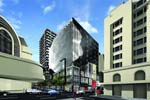 Arkehefield / ARM Arkhefield and Ashton Raggatt McDougall (ARM): Q and A Building (2009), Brisbane 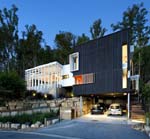 Christopher Frederick Jones Base Architecture: Stonehawke House (2008), Brisbane 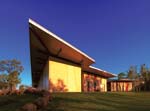 Richard Pearse Photography BVN Architecture: James Cook University, School of Creative Arts (2008), Townsville  Cox Rayner Architects Cox Rayner Architects: Kurilpa Bridge (2009), Brisbane 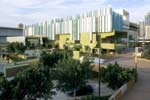 Jon Linkins Donovan Hill: Queensland State Library Extension (2006), Brisbane 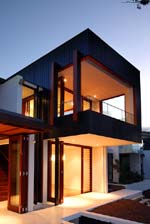 Highshots Photography Elizabeth Watson Brown Architects: River House 1 (2007), Brisbane  Graham Philip Photographer Fairweather Proberts Architects: Kelvin Grove Urban Village Lot 6 (2007), Brisbane 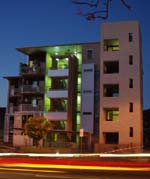 Sacha O'Toole Gall & Medek Architects: Lady Bowen Precinct Stage 3 (2009), Brisbane 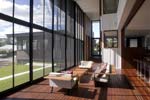 Jon Linkins James Russell Architect: Sanctuary Place House (2007), Brisbane 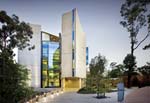 Christopher Frederick Jones John Wardle Architects and Wilson Architects: Queensland Brain Institute (2007), Brisbane  Peter Hyatt/Hyatt & Associates JMA Architects: Cooroy Studio (2007), Cooroy 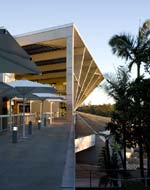 Jon Linkins M3 Architecture: Brisbane Girls Grammar School Cherrell Hirst Creative Learning Centre (2007), Brisbane  Noel Robinson Architects Noel Robinson Architects: Sohar University (projected 2011), Sultanate of Oman 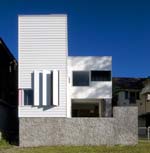 Jon Linkins Owen & Vokes: Bulima Boathouse (2009), Brisbane 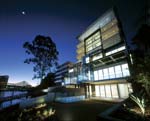 Scott Burrows / Aperture + Associates Plazibat + Jemmott Architects: Ciel Apartments (2007), Brisbane 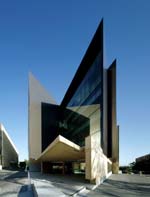 Scott Burrows / Aperture + Associates Richard Kirk Architects: Sir Llew Edwards Building, University of Queensland, St. Lucia (2008), Brisbane  Christopher Frederick Jones Riddel Architecture: Point Lookout House, Aquila (2002), North Stradbroke Island 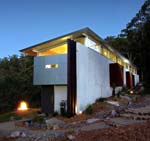 Jesse Lockhart-Krause Sparks Architects: Honeydew Residence (2006), Sunshine Coast  Troppo Architects Troppo Architects: Bungalow Bay Resort (2004), Magnetic Island 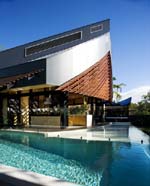 Patrick Bingham-Hall Charles Wright Architects: Wright House (2007), Port Douglas |
© 2009 ArchNewsNow.com